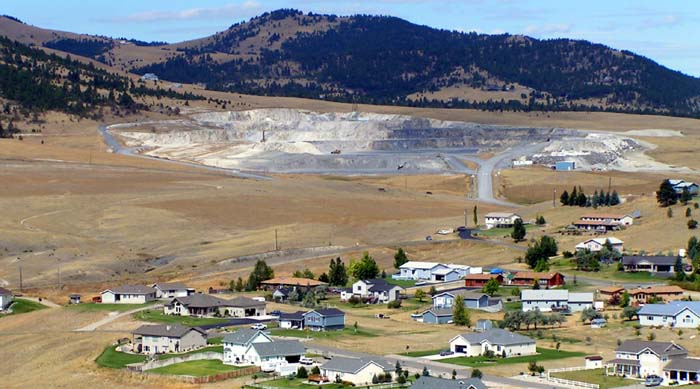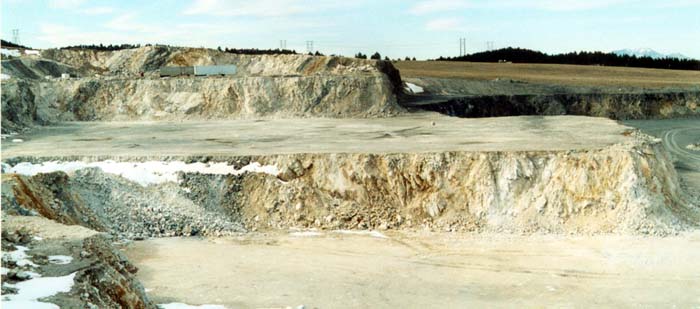|
Where Cement Comes From 
Limestone Quarry . . .
The photos on this page were both taken near Montana City, a community located 5 miles southeast of Helena. Here a light-colored rock, called Madison Limestone, can be found just beneath the soil, making this a convenient place for a quarry. Ash Grove Cement Company removes limestone from the quarry and hauls it to a plant just a few miles away where it is used to make cement. A quarry is sort of like a mine. However, at a mine the rock (called ore) is removed because it contains a valuable metal, which must then be removed by processes such as milling, leaching, and smelting. On the other hand, at a quarry it is the rock itself that the company is after.
A deposit of calcite sediment . . .
The Madison limestone is primarily made up of the mineral called calcite (calcium carbonate; CaCO3). This rock is made of sediment that was deposited on the floor of a shallow ocean about 340 million years ago. Marine organisms took calcium carbonate out of the water and built shells or other hard parts. As these organisms died their soft tissues decayed, but the shells, etc. made of calcite built up as sediment on the sea floor. Judging by the thickness of the Madison Limestone, found here and in other parts of Montana, this tropical marine environment persisted for many millions of years.
Why limestone . . .
Limestone is primarily made up of the mineral calcite whose chemical formula is CaCO3. As Ashgrove heats the limestone (CaCO3 aka calcite) to 1000 C lots of CO2 is given off as the calcite changes to CaO. This step releases so much CO2 into the atmosphere that cement production is one of the top five sources of the CO2 emissions in the USA. In the next step, the CaO is heated to 1500 C and it reacts with silica to form calcium silicate. The most common combination of materials used to make cement is limestone, clay and sand. These materials are crushed and then processed in a furnace called a kiln where temperatures reach 1500 C (2730 F). The intense heat causes chemical reactions that convert the partially molten raw materials into pellets of calcium silicate called clinker. After adding some gypsum and other key materials, the mixture is ground into the extremely fine gray powder that we call "cement".
The carbon cycle . . .
Limestone stores huge amounts of carbon for millions of years. As Ashgrove heats the limestone, this carbon returns to the atmosphere in the form of CO2. Another (natural) way that the carbon can return is through volcanism. If this limestone were ever to be melted into a magma, the carbon may be expelled as CO2 when the volcano erupts. Based on the current motion of Earth's tectonic plates, it doesn't look like this will be happening to the limestone in Ashgrove's quarry any time soon.
What's the difference between cement and concrete? . . .
Although the terms cement and concrete often are used interchangeably, cement is actually one of the ingredients used to make concrete. The other ingredients are sand and/or gravel (aggregate), and water. Typically, concrete is about 10 to 15 percent cement, 60 to 75 percent aggregate and 15 to 20 percent water.
If it can't be grown it has to be mined . . .
No one likes to see the land torn up, but we all benefit from buildings, roads, and sidewalks made of concrete. Although 93 % of U.S. highways are paved with asphalt, 40 % of our interstate highways are made of concrete. Below: Here is a closer view of Ash Grove's limestone quarry at Montana City. 
Term: silica, aggregate
|









